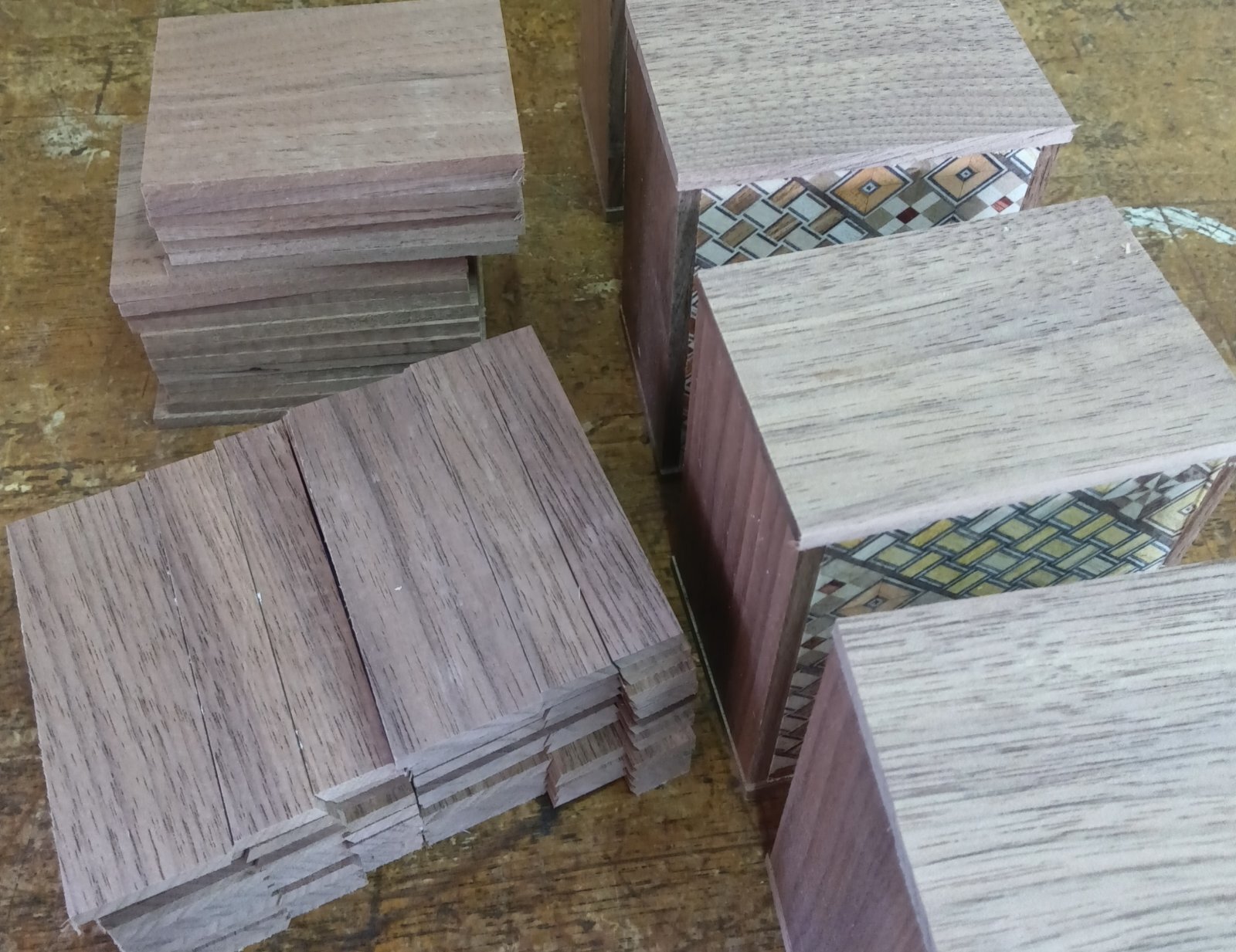Tiny aruki panels
Today, the weather was a bit cloudy, so I was a little concerned about the humidity. But I went ahead with the planned panel gluing work. The 2.5-sun box, which already had its panels attached, is now being stored in a humidity-controlled case. Today, I worked on attaching the panels for the 3-sun box with the 7-step mechanism. As I mentioned briefly yesterday, even for this 7-step box, the outer panels of Aruki (this time made with walnut wood) can be glued in a single day. So I followed the plan and completed that process today. With that, the full assembly of the 3-sun box is now finished.
According to the plan, I will do the finishing work on these two types of boxes tomorrow.
Today, I had to go out for a bit, so I didn’t have as much time to work as usual. However, I really wanted to finish installing the Aruki panels for the Mame puzzle boxes by the end of the day. There were quite a lot of them, but I managed to get it done. As expected, doing so many of these installations makes my hands hurt..haha. Times like this remind me how important it is to choose the right wood for the Aruki panels. The best aruki panels are made from wood that is soft and slightly elastic — this creates that simple, charming movement unique to Japanese puzzle boxes. Right now, I’m using Agathis wood from Southeast Asia, but ideally, I think Japanese katsura wood is the best choice. It would be great to use it for the entire mechanism of the box, but it’s hard to find good quality katsura. So when I’m able to get even a small amount, I sometimes use it only for the Aruki panels in the Mame puzzle boxes. Its soft and springy texture is perfect for expressing the gentle, traditional feel of puzzle box movements. And since the wood is light, it also helps convey that classic, nostalgic atmosphere that traditional Japanese puzzle boxes (himitsu-bako) are known for.
If you ever find a Japanese puzzle box or Karakuri box from Japan's "Showa era"—a piece made 40 to 50 years ago or more—on an auction site or elsewhere, you’ll likely come across an original puzzle box made with those traditional materials.
Now, about the instruction sheets for opening the knock box, which I had been struggling with a bit — yesterday, I finally found a free illustration that fits just right. By using that image to show how to open the box, I was able to complete the instructions at last. I'm still not sure if it's easy to understand, but I think when it's combined with the written explanation, it should be clear enough to follow. This time, unlike my usual puzzle boxes, the mechanism doesn’t only involve sliding panels, so I couldn’t rely on just using arrows to explain everything, it was a tricky task. Also, since the first step is a bit long to explain 😅 I ended up using both sides of the instruction sheet.
According to the plan, I will do the finishing work on these two types of boxes tomorrow.
Today, I had to go out for a bit, so I didn’t have as much time to work as usual. However, I really wanted to finish installing the Aruki panels for the Mame puzzle boxes by the end of the day. There were quite a lot of them, but I managed to get it done. As expected, doing so many of these installations makes my hands hurt..haha. Times like this remind me how important it is to choose the right wood for the Aruki panels. The best aruki panels are made from wood that is soft and slightly elastic — this creates that simple, charming movement unique to Japanese puzzle boxes. Right now, I’m using Agathis wood from Southeast Asia, but ideally, I think Japanese katsura wood is the best choice. It would be great to use it for the entire mechanism of the box, but it’s hard to find good quality katsura. So when I’m able to get even a small amount, I sometimes use it only for the Aruki panels in the Mame puzzle boxes. Its soft and springy texture is perfect for expressing the gentle, traditional feel of puzzle box movements. And since the wood is light, it also helps convey that classic, nostalgic atmosphere that traditional Japanese puzzle boxes (himitsu-bako) are known for.
If you ever find a Japanese puzzle box or Karakuri box from Japan's "Showa era"—a piece made 40 to 50 years ago or more—on an auction site or elsewhere, you’ll likely come across an original puzzle box made with those traditional materials.
Now, about the instruction sheets for opening the knock box, which I had been struggling with a bit — yesterday, I finally found a free illustration that fits just right. By using that image to show how to open the box, I was able to complete the instructions at last. I'm still not sure if it's easy to understand, but I think when it's combined with the written explanation, it should be clear enough to follow. This time, unlike my usual puzzle boxes, the mechanism doesn’t only involve sliding panels, so I couldn’t rely on just using arrows to explain everything, it was a tricky task. Also, since the first step is a bit long to explain 😅 I ended up using both sides of the instruction sheet.

